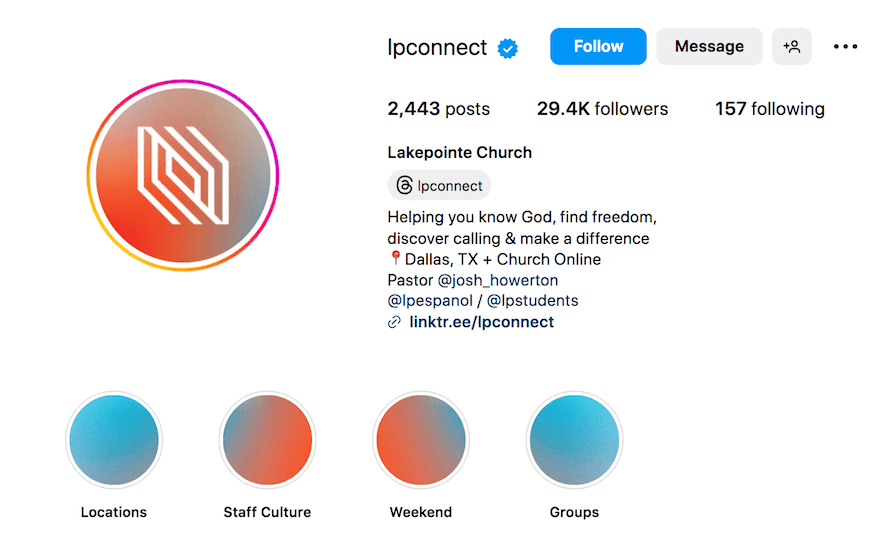11 Effective Social Media Strategies for Churches in 2024
Our independent research projects and impartial reviews are funded in part by affiliate commissions, at no extra cost to our readers. Learn more
Since you’re here, it’s likely your church already has a website – and, if it doesn’t, our list of the best church website builders can help you find the right platform to build one with.
But what about social media?
Churches and social media do, after all, have a lot in common. They’re both in the business of connecting people. And with an incredible 4.8 billion social media users out there, it’s smart to develop a strong church social media strategy to reach them.
Below, you’ll find a complete guide to church social media, with 11 tried-and-tested social media strategies for churches. Between offering live-streaming services, hosting social media takeovers, and creating behind-the-scenes church content, these actionable insights will help you build and engage a strong, faith-based community.
So let’s dig in!
1. Live-Streaming Services and Events
Why limit your church’s services and events to your local congregation members alone – when there’s a whole world full of worshippers you could be reaching?
Live-streaming your sermons can connect your church with a wider, global audience. This promotes inclusivity, giving access to people – who, because of old age, disabilities, mobility issues, or mere geographical location – are unable to attend in person. And features such as live chat enable real-time interaction between hosts and viewers.
Some events you could look to stream live include virtual youth group meetings, Bible studies, and educational sessions (more on those shortly). You’ll also ensure your church is catering to younger, more tech-savvy generations – who use this technology every day in their school and home lives – and, in doing so, stay relevant.
Facebook is a particularly useful tool for hosting virtual events. To find out more, Facebook’s guide to this topic will help.

2. Virtual Volunteer Opportunities
Engaging your church members is a vital part of fostering connections and community while enabling you to run your church sustainably.
And, by tapping into the internet, you can unlock exciting new opportunities, including:
- Online prayer teams, where certain members of your congregation can help others by answering questions posed to your church on social media.
- Bloggers and writers to contribute to your church’s website, develop a unique tone of voice for your congregation, and widen your reach.
- Social media managers to curate content for your church’s Facebook, Instagram, TikTok, Pinterest, and X accounts.
- Virtual event coordinators to help run your church’s webinars, online workshops, and digital conferences: coordinating speakers, moderating discussions, and providing technical support.
- Translators – especially important if your church has a diverse community – to ensure your church’s content is accessible in different languages.

3. Story Highlights and Testimonials
Testimonials from your church members are vital for engaging new members and being able to demonstrate the success of your work to the wider community.
And, through social media platforms like Facebook and Instagram, you can share these testimonials as ‘stories’: even using images of videos of the people giving the testimonials to add a more personal, and engaging, touch.
Once you have a few saved, you can compile these testimonials as story ‘highlights’: featuring them all in a dedicated, designated spot on your church’s social media accounts so they’re easy for prospective new members of your flock to locate, view, and be enticed by.

4. Themed Social Media Challenges
Everyone loves a fun challenge – and social media can be an excellent way for your church to run them, engaging your congregation with a common cause in a fun, novel way.
These challenges can relate to specific themes: such as faith, community, or personal growth.
Some examples include:
- Prayer challenges to encourage participants to deepen their prayer lives and build a stronger connection with God: sharing their experiences with prayer, and using designated hashtags focusing on gratitude or personal reflection.
- Acts of kindness challenges to inspire your congregants to spread love and positivity throughout their communities: volunteering, helping a neighbor, or even sharing stories of kindness and devotion via their own social media accounts.
- Scripture memorization challenges to promote a better understanding of the bible. Encourage participants to share videos of themselves reciting the scripture, and share their insights and reflections on the chosen passage with a designated challenge hashtag.
Be sure to set a specific timeline around each challenge, and – once it’s done – share the results via your church’s social media channels. This will ensure that each participant feels seen and rewarded, encouraging participation in future challenges.

5. Customized Emojis and Stickers
Emojis and stickers are as much a part of the modern lexicon as words and punctuation – and they’re a language your church needs to be speaking.
So collaborate with artists – or, for a DIY approach, use design tools such as Moji Maker for iOS or Bitmoji for Android – to produce unique, customized emojis and stickers relevant to your church. These will be useful not only for your church’s social media team, but as something all members of your congregation can use online when talking about your church. This will help facilitate their creative expression, while widening your church’s appeal and online presence, too.

6. Educational Webinars and Live Sessions
Remember how you can use the internet to host virtual events and live-stream services? Well, you can do the same for any message your church needs to share with the world.
Running educational webinars – on topics such as theology, personal development, or the nature of faith in a changing world – is an excellent way of widening the scope of your church’s audience. You can incorporate live Q&A sessions to help participants feel involved, and use these webinars to feed into fundraising and community outreach initiatives.
Of course, these webinars need an audience – and here’s where social media comes in.
So be sure to promote your webinars across all your social media platforms: using high-quality images and graphics to give attendees details including the event time and date, as well as a link to access the live webinar.

7. Environmental and Social Initiatives
Faith and religion are about inspiring people to do good, and be better – not only unto other people, but to the planet we live on, too.
That means shouting about environmental sustainability and social justice – and what better way to do that than social media?
Some of the ways you can do this include:
- Sharing information on your church’s community service projects, charitable activities, and outreach programs through your church’s social media platforms.
- Encouraging your church’s followers on social media to participate in local or global initiatives around ecological or social issues, then share that involvement through their own social channels. (And tag your church in their posts!)
- Amplifying the impact of your church’s charitable efforts by talking about it on social media, and recruiting members of your congregation to get involved.

8. Prayer Requests and Virtual Prayer Gatherings
With social media, facilitating prayer requests and virtual prayer gatherings is so much easier.
You can, for instance, set up a unique and easily recognizable hashtag – such as #PrayForOurCommunity – to encourage members of your church to share their requests through their favorite social media platform. This cultivates a culture of transparency and support within your congregation while making it easier for members of your church to track – and respond to – these prayer requests across multiple social platforms.
As for virtual prayer gatherings, video conferencing tools – think Zoom or Facebook Live – can work wonders. Plus, their range of features allows you not only to boost participation levels through comments or questions but also incorporate slots for worship, guided prayer, and communal intercession within the virtual gathering.
Just remember to promote these virtual gatherings everywhere you can on social media in the leadup to the event to remind people they’re happening, and give them all the details!

9. Social Media Takeovers by Church Members
A social media takeover is when you hand over the reins to your church’s social media accounts to someone not normally responsible for their maintenance.
This could be to another member of your church’s staff, or even to a member. (But don’t worry, it doesn’t have to be for more than a day!)
Why are social media takeovers important for your church? Well, because they allow you to amplify the diverse voices that make up your congregation. To hand the microphone over to people who might not normally have a voice, and give them a platform to share inspiring personal stories, fun daily routines, or insightful reflections about their own faith journey.

10. Behind-the-Scenes Content
Everyone loves a peek behind the curtain; a rare, insider glance into the goings-on of a church.
So why not offer it to them? Sharing behind-the-scenes glimpses into church life – such as how you prepare for services, host events, and coordinate volunteering activities – can be a brilliant way of bridging that gap between your church’s team and its congregation. It’s also a chance for you to further humanize the people responsible for your church’s upkeep, and showcase the dedication and teamwork that go into everything you do for your community.
To this end, platforms like Instagram Stories and Facebook Live enable the real-time streaming of unscripted content about the stuff your congregation doesn’t see every day. It’s an inclusive, immersive way to foster a sense of transparency and authentic connection around your church, and trust us – your congregation will love you for it!

11. Faith-Based Podcast Series
There are almost half a billion (460 million) podcast listeners in the world – so, needless to say, this is a market your church should be tapping into.
How? Through planning, putting together, and promoting a podcast series created and managed by your own church. You can cover topics such as sermons, the relationship between faith and life, and even promote your church’s events and initiatives.
Pick one or two dedicated hosts, but – to diversify the voices on the podcast – invite different guest speakers, theologians, or local community leaders to the microphone each week to contribute.
Once your podcast is underway – and live on platforms such as Apple Music and Spotify – you can amplify it across various social media platforms such as Facebook, X, and Instagram.
Be sure, too, to encourage your congregants to listen, discuss, and share your podcast’s episodes. In this way, podcasts are an important instrument for outreach and can help your church attract a wider audience interested in faith-related content.

Church Social Media Strategy: Summary
While the words “church social media strategy” might provoke an initial reaction of panic, it doesn’t have to. Because, as we’ve seen here, church social media can be broken down into a set of smaller strategies; bite-sized ideas your church can implement, one by one, to engage your social media following and attract new worshippers and adherents.
So, let’s quickly recap those top 11 church social media strategies again:
- Live-streaming services and events
- Virtual volunteer opportunities
- Story highlights and testimonials
- Themed social media challenges
- Customized emojis and stickers
- Educational webinars and live sessions
- Environmental and social initiatives
- Prayer requests and virtual prayer gatherings
- Social media takeovers by church members
- Behind-the-scenes content
- Faith-based podcast series
That’s just about it from us! For more, dive into our FAQ section below, or explore our detailed guide on how to create a social media strategy for your church.
FAQs
The best website builders make it easy to put together a website without busting your budget – and you won’t need to know how to code, either.
For inspiration, our top 14 church website template picks are the perfect place to start!
Leave a comment